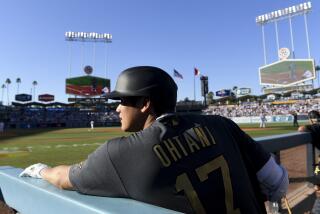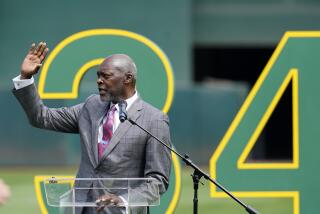Old Comiskey Park, Once a Palace, May Soon Be Abandoned
- Share via
CHICAGO — Comiskey Park was called the “Baseball Palace of the World” when it opened as the home playground of the Chicago White Sox 76 years ago.
But the oldest park still used for major league baseball may soon be abandoned. Sox owners have threatened to move to greener pastures--Addison, in suburban Du Page, or even farther away to Washington, D.C., or Denver.
The prospect angers some residents of the city’s Bridgeport neighborhood on the South Side, where the stadium has long been a place to take the family on a summer night.
“It’s a shame they want to take a tradition out of Chicago,” said Frank Basic, 55, a bartender at Danny O’Brien’s tavern, across from the park. “I would lose my job.”
“They better stay here,” said Leon Strawder, a South Side fan. “It’s a tradition. The suburbs--no way. I’m a major Sox fan but I won’t go to the suburbs.”
Many baseball players also like the 44,000-seat stadium.
Comiskey “is the best park in the American League for me,” said Sox shortstop Ozzie Guillen, the AL’s 1985 Rookie of the Year. “It has the best infield and the best scoreboard. I’ve had a lot of fun here.
“But, I’ll play anywhere. If they build a stadium in Venezuela I’ll play there,” said Guillen, who hails from that country.
Ken “Hawk” Harrelson, White Sox vice president for baseball operations, said maintaining the aging stadium is costing the club too much money.
“Not to be disrespectful, but it takes a lot less for a 22-year-old girl to pretty herself than it does a 76-year-old woman,” Harrelson said. “It’s the same thing with a ballpark.”
Howard Pizer, another Whie Sox vice president, said the club spent $300,000 this spring on structural work and other repairs at Comiskey.
“The money going into this stadium could go for player development or for the minor league system and other things,” Harrelson said.
Du Page County officials are trying to lure White Sox co-owner Jerry Reinsdorf to the suburbs, but Reinsdorf said, “If we can’t make it in Illinois, we will have to look elsewhere.”
However, Joe Pinotti, 75, a Comiskey Park security guard and lifelong Bridgeport resident, thinks Reinsdorf may be “putting a squeeze play on the city” to get a new stadium in Chicago.
The benefits of a major sports team are not lost on city officials, who estimate the city’s economy lost more than $1 million a day during the baseball players’ strikes, which also sidelined the cross-town Chicago Cubs.
Mayor Harold Washington, meanwhile, has appointed a panel to explore sites for a new stadium to house the White Sox, Cubs and the NFL Bears.
In the past, neighbors have complained about noise, traffic and rowdy fans at the park, but Basic, the bartender, said, “I never heard anybody in the neighborhood say they want the Sox to go.”
That’s because many of them depend on Comiskey Park for their livelihood.
For example, Danny O’Brien’s and McCuddy’s, taverns which sit side-by-side near the park, are open only 81 days a year -- when the Sox play at home.
In 1976, the Sox were set to move to Seattle, but the franchise was rescued by the late Bill Veeck, who headed an investment group that bought the team and operated it for five years.
Veeck whitewashed every nook and cranny of the park and ripped up the artifical turf covering the infield, replacing it with grass. He introduced tacos, pizza and picnic tables, and hung children’s art on the walls in an effort to make Comiskey more enjoyable for the whole family.
For many, the park is filled with memories.
“This is the ballpark I’ve come to all my life” said Sharon Recchia, 21, a beer vendor at the park. “I’ve always been a White Sox fan.”
The Sox moved into Comiskey in 1910, after playing at a converted cricket field four blocks away. They prompty lost their first game, a 2-0 decision to the St. Louis Browns.
The park has been site of three All-Star games, including a gala 50th anniversary celebration, and four World Series.
Hall of Famers Eddie Collins, Luke Appling, Early Wynn, Luis Aparicio and Hoyt Wilhelm have called Comiskey home. Babe Ruth was the first of a number of sluggers to hit a home run on or over the roof.
Comiskey was also rocked by the “Black Sox” scandal, when “Shoeless Joe” Jackson and several other Sox players were accused of conspiring with gamblers to throw the 1919 World Series.
In 1979, the Sox had to forfeit a game because the field was damaged during Disco Demolition Night, when fans’ disco records were burned in the stadium and a near-riot ensued.
After the team won the American League West title in 1983, the White Sox set a club home-attendance record the next season, drawing 2,136,988.
Basic thinks the Sox will be gone in three years.
“That’s how long it will take them to build a new stadium somewhere,” he said.
And he thinks something special will be lost if the team moves to the suburbs, far from the complex transportation network that now feeds Comiskey.
“Baseball is for the kids, right?” he asked. “Well, kids can come here by themselves on the train or bus. They can’t do that in Addison.”
More to Read
Go beyond the scoreboard
Get the latest on L.A.'s teams in the daily Sports Report newsletter.
You may occasionally receive promotional content from the Los Angeles Times.










